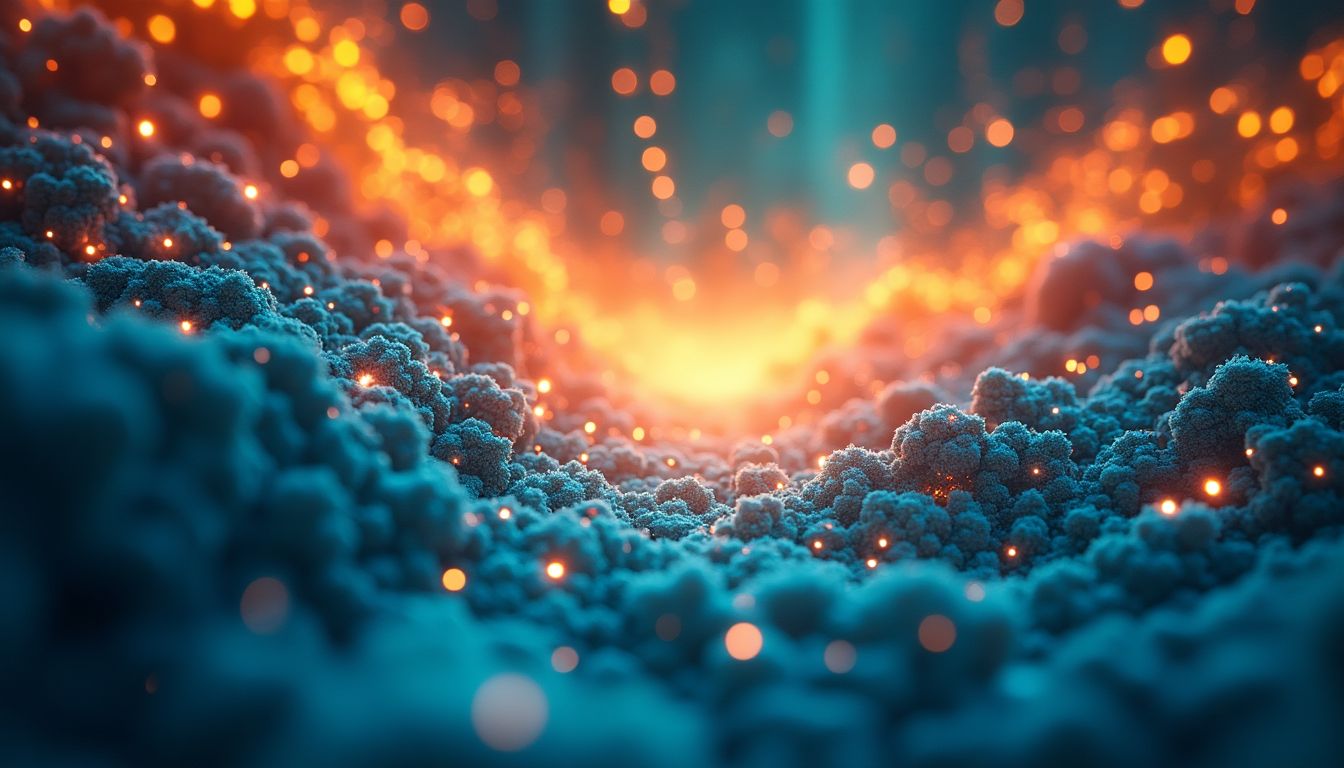What if the key to solving the world’s energy crisis was hiding in plain sight, buried in the labyrinth of atoms and electrons? The answer might lie in a material so revolutionary it could redefine how we generate, transmit, and use energy: room-temperature superconductors. These materials, capable of conducting electricity without resistance, have long been the stuff of scientific dreams. But dreams, as we know, are often just a step ahead of reality. Enter the AI chemist—a digital alchemist that’s turning the impossible into the inevitable.
Think about it: every time you flip a light switch, charge your phone, or power up your laptop, a small but significant amount of energy is lost as heat due to resistance in the wires. Multiply that by billions of devices worldwide, and you’ve got a colossal waste of energy. Room-temperature superconductors could change that, slashing energy losses and paving the way for a zero-carbon future. But here’s the catch: despite decades of research, these materials remain elusive. That’s where artificial intelligence steps in, armed with algorithms sharper than a lab coat’s crease and faster than a grad student on their third cup of coffee.
Renowned physicist Brian Cox once quipped, “Science is not about control. It’s about understanding.” But what if AI could give us both? Visionaries like Fei-Fei Li, a pioneer in AI, and Michio Kaku, a futurist and theoretical physicist, have long argued that AI could unlock the secrets of the universe. Now, their predictions are coming to life in the quest for superconductors. This article dives into how AI is rewriting the rules of materials science, one atom at a time, and why this could be the breakthrough humanity desperately needs.
1. The Science of Superconductivity: Why Room-Temperature Superconductors Matter
1.1 What Are Superconductors?
Superconductors are like the Usain Bolt of materials—they can conduct electricity at lightning speed without losing energy as heat. This phenomenon, known as zero electrical resistance, was first discovered in 1911 by Dutch physicist Heike Kamerlingh Onnes. He found that mercury, when cooled to near absolute zero (-273°C), suddenly lost all resistance to electric current. This discovery earned him a Nobel Prize and kicked off a century-long quest to find materials that could do the same at higher temperatures.
But superconductors aren’t just about zero resistance. They also exhibit the Meissner effect, which allows them to repel magnetic fields. This is why you’ve probably seen videos of levitating trains or floating magnets—superconductors are the secret sauce behind these futuristic feats. However, there’s a catch: most superconductors only work at cryogenic temperatures, making them impractical for everyday use. That’s why scientists are racing to find materials that can superconduct at room temperature, or at least close to it.
1.2 The Energy Challenge
Let’s talk numbers. According to the International Energy Agency, global energy systems lose about 5-10% of electricity during transmission and distribution. That might not sound like much, but it adds up to billions of dollars and millions of tons of CO2 emissions every year. Imagine if we could eliminate those losses entirely. Room-temperature superconductors could make that dream a reality, enabling power grids to operate at 100% efficiency.
The environmental impact would be staggering. By reducing energy waste, we could cut greenhouse gas emissions, slow climate change, and make renewable energy sources like wind and solar even more viable. But the benefits don’t stop there. Superconductors could also revolutionize industries like transportation, healthcare, and computing. Magnetic levitation trains, more efficient MRI machines, and faster quantum computers are just a few of the possibilities.
1.3 The Room-Temperature Dream
So, why haven’t we cracked the code yet? The answer lies in the complexity of materials science. Superconductors are finicky creatures, requiring just the right combination of elements, structure, and conditions to work. Over the years, scientists have made incremental progress, discovering high-temperature superconductors that work at -135°C. But room temperature? That’s still the holy grail.
The stakes are high, and the competition is fierce. From academic labs to corporate R&D departments, everyone wants to be the first to discover a room-temperature superconductor. Governments are pouring billions into research, and organizations like the United Nations are promoting superconductors as a key tool in the fight against climate change. But with AI entering the fray, the game is changing. By analyzing vast datasets and simulating millions of material combinations, AI is accelerating the discovery process, bringing us closer to the dream than ever before.
2. The Challenges of Discovering Room-Temperature Superconductors
2.1 The Complexity of Materials Science
Imagine trying to find a needle in a haystack, except the haystack is the size of the Milky Way, and the needle keeps changing shape. That’s essentially what materials scientists face when searching for room-temperature superconductors. The chemical space is vast—billions of potential combinations of elements and structures exist, each with unique properties. Traditional methods rely on trial and error, which is like trying to win the lottery by buying one ticket at a time. It’s slow, expensive, and often frustrating.
Take, for example, the work of Heike Kamerlingh Onnes, who discovered superconductivity in 1911. Back then, scientists had to cool materials to near absolute zero to observe the phenomenon. Fast forward to today, and we’re still playing with extreme temperatures, albeit slightly warmer ones. The challenge? Finding a material that can superconduct at room temperature without requiring a PhD in patience.
2.2 Theoretical vs. Practical Hurdles
On paper, room-temperature superconductors sound like a slam dunk. But in reality, the gap between theory and practice is wider than the Grand Canyon. Theoretical models can predict how materials should behave, but synthesizing them in the lab is a whole different ball game. Stability, scalability, and cost are just a few of the hurdles. For instance, a material might superconduct beautifully in a lab but fall apart when exposed to air or moisture. It’s like designing the perfect car that only works in a vacuum.
Quantum mechanics adds another layer of complexity. Understanding how electrons pair up and move without resistance requires solving equations that would make even Einstein scratch his head. And let’s not forget the cost of experimentation. Building and testing new materials isn’t cheap, and funding for such high-risk, high-reward research can be as elusive as the superconductors themselves.
2.3 The Role of AI in Overcoming These Challenges
Enter AI, the superhero of modern science. Artificial intelligence can analyze mountains of data, spot patterns, and make predictions faster than you can say “superconductor.” Machine learning algorithms can sift through decades of research, identifying promising candidates that humans might overlook. It’s like having a crystal ball, but one that’s powered by data and algorithms.
For example, researchers at MIT used AI to discover a new antibiotic by analyzing thousands of chemical compounds. If AI can find a needle in the haystack of antibiotics, why not superconductors? By combining AI with quantum simulations and high-throughput experimentation, scientists can accelerate the discovery process, turning years of research into months or even weeks.
3. The Rise of the AI Chemist: How AI is Transforming Materials Discovery
3.1 What is an AI Chemist?
An AI chemist is like a mad scientist, but without the messy lab coat and wild hair. It’s an artificial intelligence system designed to predict, design, and optimize materials. Using machine learning, neural networks, and generative models, AI chemists can explore the chemical universe in ways that were once unimaginable. Think of it as a supercharged version of your high school chemistry teacher, but one that never sleeps and doesn’t grade on a curve.
Key technologies driving this revolution include frameworks like TensorFlow and PyTorch, which power the machine learning models. These tools allow AI to learn from data, make predictions, and even generate new material structures. It’s like giving a computer a chemistry set and saying, “Go wild.”
3.2 AI in Action: Case Studies
AI isn’t just a theoretical concept—it’s already making waves in materials science. Take, for example, the work of IBM, which used AI to design new catalysts for renewable energy. These catalysts can speed up chemical reactions, making processes like hydrogen production more efficient. Similarly, researchers at Stanford University used AI to discover new battery materials for electric vehicles, potentially extending their range and reducing charging times.
These breakthroughs are just the tip of the iceberg. AI is also being used to design more efficient solar panels, stronger alloys, and even new drugs. The common thread? AI’s ability to analyze vast amounts of data and identify patterns that humans might miss. It’s like having a cheat code for science.
3.3 The Potential for Superconductors
So, how can AI help us find room-temperature superconductors? By leveraging its predictive power, AI can identify promising material candidates from the vast chemical space. Quantum simulations can then validate these predictions, ensuring that the materials not only look good on paper but also work in the real world. High-throughput experimentation, powered by robotics and AI, can test these materials at scale, turning the discovery process into a well-oiled machine.
Imagine a future where AI designs a superconductor, quantum simulations confirm its properties, and robots synthesize and test it—all in a matter of days. It’s not science fiction; it’s the future of materials science. And with AI leading the charge, that future might be closer than we think.
4. The Ethical and Societal Implications of AI-Driven Discovery
4.1 Who Owns the Discovery?
When AI designs a groundbreaking material like a room-temperature superconductor, who gets the credit? Is it the scientists who trained the AI, the company that funded the research, or the AI itself? This question isn’t just philosophical—it has real-world implications for intellectual property (IP) and commercialization. For example, if IBM or Google develops an AI that discovers a superconductor, do they own the patent? Or should the discovery be part of the public domain, accessible to all for the greater good?
This debate is already playing out in the world of AI-generated art and music. In materials science, the stakes are even higher. Open science initiatives like the Materials Project are pushing for collaborative, transparent research. But corporations often guard their discoveries closely to maintain a competitive edge. Striking a balance between innovation and accessibility will be crucial as AI-driven discoveries become more common.
4.2 The Environmental Impact of AI
AI is a double-edged sword when it comes to sustainability. On one hand, it can help us design materials that reduce energy waste and combat climate change. On the other, training large AI models consumes massive amounts of energy. For instance, training a single AI model like GPT-3 can emit as much carbon as five cars over their lifetimes. That’s a lot of energy for a tool meant to save the planet!
Here’s a breakdown of the environmental costs of AI:
- Energy Consumption: Training AI models requires powerful GPUs and data centers, which are energy-intensive.
- Carbon Emissions: The electricity used often comes from non-renewable sources, contributing to greenhouse gases.
- E-Waste: The hardware used for AI becomes obsolete quickly, leading to electronic waste.
To mitigate these impacts, researchers are exploring greener AI practices, such as using renewable energy for data centers and developing more efficient algorithms. Companies like Microsoft and Google are already committing to carbon-neutral AI development. But as AI scales up, so must our efforts to make it sustainable.
4.3 The Future of Work in Science
AI is reshaping the role of human scientists. Instead of spending years in the lab testing materials, researchers can now focus on interpreting AI-generated data and designing experiments. This shift requires a new kind of scientist—one who is as comfortable with coding and machine learning as they are with test tubes and microscopes.
Here’s how AI is changing the scientific workforce:
- Interdisciplinary Collaboration: AI brings together physicists, chemists, computer scientists, and engineers to solve complex problems.
- New Skills: Scientists need to learn programming languages like Python and tools like TensorFlow to stay relevant.
- Job Creation: While some traditional roles may disappear, new opportunities in AI-driven research are emerging.
Institutions like MIT and Stanford are already adapting their curricula to prepare the next generation of scientists for this AI-driven future. The challenge is ensuring that this transition is inclusive and equitable, so everyone can benefit from the AI revolution.
5. The Road Ahead: From Discovery to Deployment
5.1 Scaling Up: From Lab to Market
Discovering a room-temperature superconductor is just the first step. The real challenge is scaling up production and integrating it into existing infrastructure. For example, how do you manufacture miles of superconducting cables for power grids? And how do you ensure these materials are cost-effective and durable?
Here are the key steps to bringing superconductors to market:
- Material Synthesis: Develop scalable methods to produce the superconductor in large quantities.
- Testing and Validation: Ensure the material performs reliably under real-world conditions.
- Infrastructure Integration: Adapt power grids, transportation systems, and other infrastructure to use superconductors.
- Policy and Regulation: Work with governments to establish safety standards and incentivize adoption.
Companies like Tesla and Siemens are already exploring how superconductors can revolutionize electric vehicles and renewable energy systems. But widespread adoption will require significant investment and collaboration across industries.
5.2 Global Collaboration for a Zero-Carbon Future
The quest for room-temperature superconductors is a global effort. From the United Nations to the Intergovernmental Panel on Climate Change (IPCC), organizations are calling for international cooperation to tackle climate change. Superconductors could play a key role in this mission by enabling more efficient energy systems.
Here’s how global collaboration can accelerate progress:
- Data Sharing: Open-access databases like the Materials Project allow researchers worldwide to share findings and build on each other’s work.
- Joint Research Initiatives: Collaborative projects between countries can pool resources and expertise.
- Policy Alignment: Harmonizing regulations and incentives across borders can speed up adoption.
For example, the European Union’s Horizon Europe program is funding research into advanced materials, including superconductors. Similar initiatives in the U.S., China, and Japan are driving progress on a global scale.
5.3 The Vision for 2050
Imagine a world in 2050 where energy flows seamlessly, power grids operate at 100% efficiency, and carbon emissions are a thing of the past. This is the promise of room-temperature superconductors. But achieving this vision will require more than just technological breakthroughs—it will demand a fundamental shift in how we produce, distribute, and consume energy.
Here’s what the future could look like:
- Lossless Energy Transmission: Superconductors eliminate energy waste, making renewable energy more viable.
- Magnetic Levitation: High-speed trains like Japan’s Shinkansen could become even faster and more efficient.
- Quantum Computing: Superconductors are key to building powerful quantum computers that can solve complex problems.
The road ahead is long, but the potential rewards are immense. By harnessing the power of AI and global collaboration, we can turn the dream of a zero-carbon future into reality. The question is: are we ready to take the leap?
6. AI Solutions: How Would AI Tackle This Issue?
6.1 Data Collection and Curation
The first step in the AI-driven quest for room-temperature superconductors is gathering and organizing data. This involves aggregating existing data from academic papers, patents, and experimental results. AI can use natural language processing (NLP) to extract relevant information from unstructured text, such as research papers from arXiv or the Nature journal. Tools like Scopus and Web of Science can help identify key studies and trends. By creating a centralized, AI-curated database, researchers can access a wealth of information in seconds, saving years of manual effort.
6.2 Predictive Modeling
Once the data is organized, AI can begin predicting new material candidates. Machine learning models, trained on known superconductors, can identify patterns and properties that correlate with superconductivity. For example, generative models like TensorFlow or PyTorch can propose novel material structures. These models can also predict critical temperatures, stability, and other key properties, narrowing down the search space from billions of possibilities to a handful of promising candidates.
6.3 Quantum Simulations
AI’s predictions need validation, and that’s where quantum simulations come in. Tools like Qiskit or VASP can simulate the behavior of proposed materials at the atomic level. These simulations, powered by supercomputers like those at Oak Ridge National Laboratory, can test whether a material exhibits superconductivity under specific conditions. By combining AI predictions with quantum simulations, researchers can validate potential candidates before ever stepping into a lab.
6.4 High-Throughput Experimentation
With validated candidates, the next step is high-throughput experimentation. AI-driven robotics can automate lab experiments, synthesizing and testing materials at unprecedented speeds. Platforms like the Materials Project provide frameworks for automating these processes. AI can analyze experimental results in real-time, refining its models and guiding the next round of experiments. This iterative approach accelerates discovery, turning years of trial and error into months of targeted research.
6.5 Iterative Optimization
The final step is iterative optimization. AI continuously updates its models with new data from experiments, using reinforcement learning to optimize material properties. For example, if a material shows promise but lacks stability, AI can tweak its composition or structure to improve performance. This feedback loop ensures that each iteration brings researchers closer to the ultimate goal: a room-temperature superconductor.
6.6 Key Technologies and Tools
- Machine Learning Frameworks: TensorFlow, PyTorch, Scikit-Learn.
- Quantum Simulation Software: Qiskit, VASP, Quantum ESPRESSO.
- High-Throughput Platforms: Materials Project, Citrine.
6.7 Collaborations
No single institution can tackle this challenge alone. Collaboration is key. Partnering with leading universities like MIT, Stanford, and the Max Planck Institute can provide access to cutting-edge research and facilities. Industry leaders like IBM Quantum, Google Quantum AI, and Tesla can bring resources and expertise to the table. Together, these collaborations can accelerate progress and share the burden of discovery.
6.8 Action Schedule/Roadmap
Here’s a detailed roadmap for discovering room-temperature superconductors using AI:
Day 1: Assemble the Team
Bring together a multidisciplinary team of AI experts, materials scientists, and quantum physicists. Key personnel could include:
- Dr. Fei-Fei Li (Stanford University): Leading AI researcher.
- Dr. Brian Cox (University of Manchester): Quantum physics expert.
- Dr. Kristin Persson (Lawrence Berkeley National Laboratory): Materials science leader.
Day 2: Begin Data Collection
Start aggregating data from existing superconductivity databases, academic papers, and patents. Use NLP tools to extract and organize relevant information.
Week 1: Train Initial Models
Train machine learning models on known superconductors using frameworks like TensorFlow and PyTorch. Focus on identifying patterns and properties that correlate with superconductivity.
Week 2: Start Quantum Simulations
Use quantum simulation software like Qiskit or VASP to validate AI predictions. Collaborate with supercomputing facilities for large-scale simulations.
Month 1: Set Up High-Throughput Labs
Automate lab experiments using robotics and AI. Platforms like the Materials Project can guide the setup of high-throughput experimentation.
Month 2: Begin Testing AI-Proposed Materials
Start synthesizing and testing AI-proposed materials in the lab. Use AI to analyze results and refine models in real-time.
Year 1: Identify Promising Candidates
By the end of the first year, identify and validate the first batch of promising candidates. Focus on materials with high critical temperatures and stability.
Year 1.5: Scale Up Synthesis
Scale up the synthesis and testing of top candidates. Collaborate with industry partners to explore manufacturing and deployment options.
Year 2: Achieve Breakthrough
Discover a room-temperature superconductor. Validate its properties through rigorous testing and peer review. Begin planning for commercialization and global deployment.
A Brighter Tomorrow: The Promise of AI-Driven Discovery
The quest for room-temperature superconductors is more than a scientific challenge—it’s a beacon of hope for a sustainable future. Imagine a world where energy flows without resistance, where power grids operate at 100% efficiency, and where the dream of a zero-carbon future is no longer a distant utopia but a tangible reality. This is the promise of AI-driven discovery.
By combining the power of AI with human ingenuity, we can accelerate the pace of innovation and unlock solutions that were once thought impossible. From predictive modeling to quantum simulations, AI is revolutionizing materials science, turning years of trial and error into months of targeted research. But this journey is not without its challenges. The complexity of materials science, the limitations of current technology, and the ethical implications of AI-driven discovery all demand careful consideration.
Yet, the potential rewards are immense. Room-temperature superconductors could transform energy systems, combat climate change, and pave the way for a brighter tomorrow. They could enable lossless energy transmission, revolutionize transportation with magnetic levitation, and unlock new frontiers in quantum computing. The possibilities are endless, and the stakes could not be higher.
As we stand on the brink of this new era, one question remains: Are we ready to embrace the power of AI and the promise of a zero-carbon future? The answer lies in our ability to collaborate, innovate, and dream big. Together, we can turn this vision into reality and create a world where energy flows freely, and the future shines brighter than ever before.
What role will you play in this transformative journey? Share your thoughts in the comments below, and don’t forget to subscribe to our newsletter for a chance to become a permanent resident of iNthacity: the "Shining City on the Web". Like, share, and join the debate—because the future is ours to shape.
FAQ
Q1: What is a superconductor?
A superconductor is a special material that can conduct electricity without any resistance. This means electricity flows through it perfectly, without losing any energy as heat. Superconductors usually work at very cold temperatures, close to absolute zero (-273°C). Think of it like a highway with no traffic jams—electricity just zooms through without slowing down.
Q2: Why are room-temperature superconductors important?
Room-temperature superconductors are a game-changer because they could work at everyday temperatures, not just super cold ones. This would mean:
- No energy loss: Power grids could transmit electricity without wasting any energy, saving billions of dollars and reducing carbon emissions.
- Better technology: Things like MRI machines, maglev trains, and even quantum computers could become cheaper and more efficient.
- Climate change solution: They could help us transition to a zero-carbon future by making renewable energy systems more effective.
Imagine a world where your phone never overheats, and your electric car charges in seconds—room-temperature superconductors could make that happen.
Q3: How does AI help in discovering superconductors?
AI is like a super-smart assistant for scientists. Here’s how it helps:
- Data crunching: AI can analyze millions of scientific papers and experiments in seconds, finding patterns humans might miss.
- Predicting materials: Using machine learning, AI can suggest new combinations of elements that might work as superconductors.
- Simulating experiments: AI can run virtual experiments on supercomputers, testing materials without needing a physical lab.
For example, IBM Quantum and Google AI are already using AI to speed up discoveries in quantum materials.
Q4: What are the challenges in creating room-temperature superconductors?
It’s not easy to make a superconductor that works at room temperature. Here’s why:
- Complex materials: Scientists have to test billions of possible combinations of elements, which takes a lot of time and money.
- Stability issues: Even if a material works in the lab, it might not be stable or cheap enough for real-world use.
- Quantum mysteries: Superconductivity involves weird quantum physics that even experts don’t fully understand yet.
But with AI, we’re getting closer. For example, researchers at MIT and Stanford University are using AI to tackle these challenges head-on.
Q5: How long will it take to discover room-temperature superconductors?
It’s hard to say exactly, but AI is speeding things up. Here’s a rough timeline:
- Short term (1-2 years): AI will help identify promising materials and run simulations to test them.
- Medium term (5-10 years): Scientists will start testing the best candidates in real-world experiments.
- Long term (10+ years): If everything goes well, we could see room-temperature superconductors being used in power grids and technology.
Organizations like the United Nations and the Intergovernmental Panel on Climate Change (IPCC) are pushing for faster progress to fight climate change.
Q6: Who is working on this right now?
Lots of smart people and organizations are racing to discover room-temperature superconductors. Here are some key players:
- Universities: MIT, Stanford University, and University of Cambridge are leading the charge.
- Companies: IBM, Google, and Tesla are investing heavily in AI and materials science.
- Governments: The U.S. Department of Energy and the European Union are funding research to make breakthroughs happen faster.
Q7: What happens if we find a room-temperature superconductor?
It would be a huge deal! Here’s what could change:
- Energy revolution: Power grids would become super efficient, reducing energy waste and cutting carbon emissions.
- New technology: Faster computers, better medical devices, and even flying cars could become possible.
- Economic boost: Countries and companies that develop this technology first could become global leaders.
It’s like finding the key to a treasure chest full of clean energy and futuristic tech.
Q8: Can AI solve all the problems in materials science?
AI is powerful, but it’s not magic. Here’s what it can and can’t do:
- Can do: AI can analyze data, predict outcomes, and speed up experiments. It’s a great tool for scientists.
- Can’t do: AI still needs human experts to interpret results, design experiments, and make ethical decisions.
Think of AI as a turbocharged engine—it makes the car go faster, but you still need a driver to steer.
Q9: What can I do to support this research?
You don’t have to be a scientist to help! Here are a few ways you can make a difference:
- Stay informed: Follow organizations like the United Nations and IPCC to learn about the latest developments.
- Advocate for funding: Support policies that fund scientific research and clean energy projects.
- Spread the word: Share articles like this one to raise awareness about the importance of superconductors and AI.
Every small action adds up to big change.
Q10: What’s the big picture?
Room-temperature superconductors aren’t just about cool science—they’re about creating a better future. Here’s the big picture:
- Climate change: They could help us transition to clean energy and reduce global warming.
- Energy equity: Efficient power grids could bring electricity to remote and underserved areas.
- Technological innovation: They could unlock new possibilities in medicine, transportation, and computing.
It’s not just about science—it’s about hope, progress, and a brighter tomorrow.
Wait! There's more...check out our gripping short story that continues the journey: The Matryoshka Obelisk
Disclaimer: This article may contain affiliate links. If you click on these links and make a purchase, we may receive a commission at no additional cost to you. Our recommendations and reviews are always independent and objective, aiming to provide you with the best information and resources.
Get Exclusive Stories, Photos, Art & Offers - Subscribe Today!





























1 comment